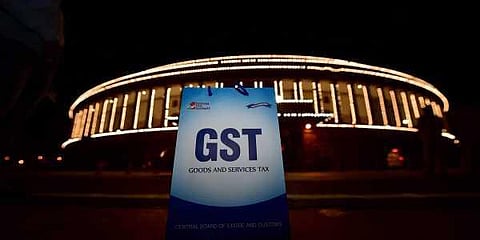

NEW DELHI: On Friday, Tamil Nadu Finance Minister P Thiaga Rajan sparked a controversy, when he said that the implementation of the Goods and Services Tax (GST) was faulty and that there is a need to
re-tool and restructure it.“Sensible people may agree or disagree on a design or system or platform, but logic says you keep re-evaluating based on the outcomes. Have you achieved the goals you wanted? Have you avoided the failures you feared? If the answer to both those is ‘no,’ logical people would say ‘re-tool, re-structure’,” Rajan said while addressing a virtual meeting organised by IIM-B’s Alumni Association, Chennai Chapter on ‘Tamil Nadu: The Road Ahead’. The criticism may sound “strongly worded” but as the GST regime is set to complete four years this week, even its strongest supporters agree that the GST regime is still a work in progress and there is a need for many structural changes for a more stable and hassle-free system.
Good intent, but marred by tech glitches & design flaws
Introduced as one of the biggest economic reforms by the BJP-led Modi government, the GST kicked off with the promise to streamline taxation and compliance burden. Experts also claimed that in many ways, it has streamlined the process. “Based on the one nation one tax ideology, GST has helped in reducing the cascading effect of tax considerably. Also, multiplicity of compliances under various indirect taxes has been reduced. Hence, introduction of GST in India has brought in efficiencies in indirect tax compliance, incidence and reduced the number of indirect tax authorities that a taxpayer needed to interact with,” said Saloni Roy, senior director, Deloitte India.
Another positive is the concept of e-invoicing which seeks to ensure greater transparency in supplier-receiver transactions. The introduction of e-way bill coupled with the crackdown on fake invoicing has helped in bringing in a substantial portion of GST revenues, which were either being evaded or under-reported, in order.
However, the technical glitches, difficulty in claiming input tax credit and ever changing rules make compliance a cumbersome business.“Input Tax Credit (ITC) is an area which has certain limitations that need to be addressed. The GST regime sought to have a seamless flow of ITC, however, conditions for availing ITC being stringent, many taxpayers lost out on ITC. Also, taxpayers lose their ITC due to non-reporting or mistakes by their suppliers,” Roy said.
That apart, taxpayers are also complaining about the imposing an arbitrary monetary limit on availing input tax credit through Rule 36(4) and mandating that a certain percentage of GST has to be paid in cash. These laws are making life difficult for even the most honest taxpayers.In the initial years of GST rollout, former finance minister Arun Jaitley had promised to reduce the tax slabs to three by merging 12 per cent and 18 per cent slabs. However, it remains a distant reality after so many years. Falling revenue amid disruptions causued by the Covid-19 pandemic has continuously delayed the reform, leaving a large number of items in high tax slabs. Lack of clarity on many rules is also leading to various litigation and different interpretations (of the same laws) by Advanced Ruling Authorities in different states.
“The government needs to establish GST Tribunals to reduce litigation timelines and the pressure on courts. The state authorities for Advance Ruling should ideally also have an independent jurist member, apart from a representative from the tax department,” Roy suggests. Centre Vs States When the states had agreed to the GST implementation, they knew they had to let go of some share of their taxes. But the Centre promised to compensate the state with revenue foregone for the first five years after implementation of GST.
The nationwide lockdown, however, intensified the problem of revenue shortfall for states with the Centre not paying up the dues on time. Also with coffers drying up and with social and health spending going up, states are growing disenchanted with the system. “We knew we were losing our independence of taxation as States. Already all direct taxation was Centre, the indirect was partially with us and the Centre. We went in with a lot of trepidation and fear and some hope of outcomes that would give long term and widespread benefit,” Rajan said, adding that five years down the line, fears have grown immensely while the benefits have not even been realised by 20-30 per cent. This largely sums up the frustration faced by many states.
Meanwhile, the meetings of the GST Council are not as frequent as they were earlier, if the recent incidents are anything to go by, and it often end up with disagreement, fight and strong letters and statements. States have also accused the Centre of cornering a substantial portion of tax in forms of cess. Last year, the GST Council had borrowed `1.1 lakh crore to pay the states in order to make up for the shortfall. Still, `63,000 crore is pending which the Centre intends to pay this year.
Road ahead As the GST council is likely to meet soon to decide on this year’s compensation, the opposition-ruled state governments are likely to seek an extension of GST compensation on their revenues beyond June 2022, when the five-year window ends. The Fifteenth finance commission, in its latest report, has addressed many issues including large shortfall in collections as compared to original forecast, high volatility in collections, accumulation of large integrated GST credit, glitches in invoice and input tax matching, and delay in refunds. The Commission also observed that the continuing dependence of states on compensation from the central government for making up for the shortfall in revenue is a concern. While at the same time it suggested that the structural implications of GST for low consumption states need to be considered.